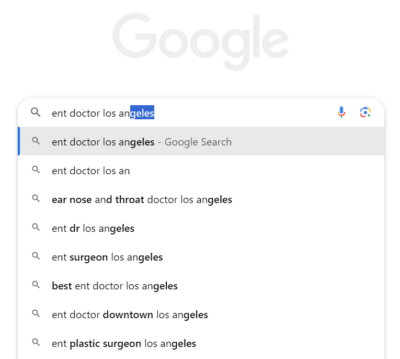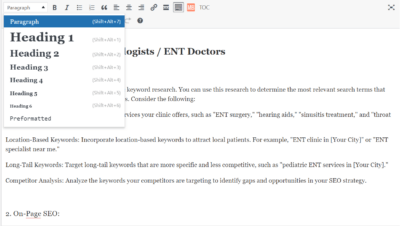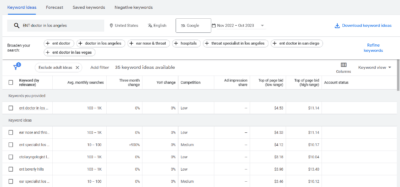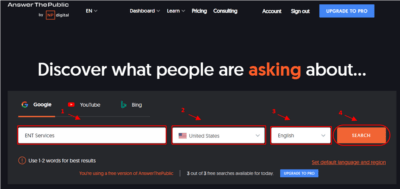SEO for otolaryngologists/ENT doctors must be given top priority by ENT clinics and practices in order to boost their online presence, bring in new patients, and establish trust. This guide will go over key strategies and recommended methods for search engine optimizing the website of your ENT practice.
Table of Contents
ToggleWhat is SEO or Search Engine Optimization?
SEO, or search engine optimization, is all about optimizing your website or page to raise your visibility and position in search engine results pages (SERPs). Its main objective is to boost organic (non-paid) traffic to a website. This makes the website more visible to consumers who are searching online for related goods, services, or information.

Improve your online visibility to attract people seeking your services.
Best Practices for SEO for Otolaryngologists/ENT doctors
-
Keyword Research:
Start by conducting thorough keyword research specific to the ENT field. This research will help you identify the most relevant search terms that potential patients are using to find ENT services. Consider the following:
Medical Specialties: Identify the specific services your clinic offers, such as “ENT surgery,” “hearing aids,” “sinusitis treatment,” and “voice disorders.”
Location-Based Keywords: Incorporate location-based keywords to attract local patients. For example, “ENT clinic in [Your City]” or “ENT specialist near me.”
Long-Tail Keywords: Target long-tail keywords that are more specific and less competitive, such as “pediatric ENT services in [Your City].”
Competitor Analysis: Analyze the keywords your competitors are targeting to identify gaps and opportunities in your SEO strategy.
Keyword Research Tools
You may use keyword research tools like Ahrefs, Ubersuggest, SEMrush, and Google Keyword Planner. These tools provide information on search traffic, competition, and related phrases.
Google Search
One of the simplest ways to find keywords is through Google Search. Here’s how you use it:
- Go to Google and on the search box, enter keywords related to your industry, products and services, such “ENT doctor,” “otolaryngologist,” or “ear nose throat specialist.”
- Autocomplete suggestions will be provided by Google, are based on common search queries, and can provide insight into what people are searching for.

Google Keyword Planner
It is a tool that Google Ads makes available and is useful for keyword research. Here’s a step-by-step guide on how to use Google Keyword Planner:
- Visit the Google Ads website and sign in with your Google account to access the Google Keyword Planner.
- After logging in, select “Tools & Settings” by clicking the wrench symbol located in the upper right corner. Click “Keyword Planner” under “Planning.”
- Several tools are available through Google Keyword Planner to discover new keywords and provide information on search volume. For now, let’s select “Discover new keywords.”

- In the space provided, type your seed keywords or phrases that are associated with your company, offerings, or services. You may also type in a specific product category or the URL of your website.

- Indicate your desired location, language, and search network when it comes to targeting. You can enter a specific location to obtain more location-specific keyword statistics.
- You can target keywords with a particular degree of competition or exclude keywords with a lower search volume from the results by applying filters. Adapt these filters to your tastes and objectives.
- A list of potential keywords will be provided by the tool, together with information on competition, average monthly searches, and proposed bid values. Examine this data to find keywords that are pertinent to your SEO plan.

- Utilize the past metrics and trends information to comprehend how the prominence of particular keywords has evolved over time. Finding seasonal trends can be aided by this knowledge.
- As you collect more information, hone your keyword strategy. Concentrate on keywords that are relevant to your business and have a balance between search volume.
- Incorporate the chosen keywords into the metadata, blog posts, and website material as part of your content strategy.
Google Trends
Visit Google Trends to explore the popularity of specific keywords over time. This tool can help you identify trending topics and seasonal variations.

Would you like to optimize your website and increase your patient volume?
-
On-Page SEO:
Effective on-page SEO ensures that your clinic’s website is optimized for both search engines and potential patients. Here’s how to enhance your on-page SEO:
Title Tags: Optimize the title tags of your pages by including relevant keywords. Make sure your titles are informative, concise, and under 60 characters.
Meta Descriptions: Craft compelling meta descriptions that include keywords and encourage users to click. Keep them under 160 characters.

URL Structure: Create clean, descriptive URLs that include keywords. Avoid using generic or numerical URLs.
Header Tags: Use H1, H2, and H3 header tags to structure your content. Include relevant keywords in your headings to improve readability and SEO.

Keyword Placement: Integrate keywords naturally into your content, but avoid keyword stuffing. Always prioritize high-quality, patient-centered content.
-
Quality Content:
To draw in patients and rank highly on search engines, you must produce informative and high-quality material. These are a few content-related strategies :
Patient Education: Provide information to patients regarding prevalent ENT ailments, available treatments, and ways to avoid them. Articles and blogs with useful information can be worthwhile.
Videos and Visual Content: Provide patient testimonials, highlight your clinic, and clarify procedures with videos and visual content. Your audience can be effectively engaged and informed by visual content.
FAQ Sections: Frequently asked questions and concerns from patients should be covered in a FAQ section. Visitors receive value from this, and SEO is also enhanced.
Consistency: Continuously provide new information to your website. Maintaining patient engagement and SEO rankings requires consistency.
One helpful resource for coming up with content ideas is Answer the Public, which gathers internet question-and-answer content. The following are detailed instructions for using Answer the Public:
- Go to the Answer the Public website.
- The site has a search bar. Type in a seed term associated with your sector, specialty, or area of interest. If you’re an ENT physician, for instance, you may type “ENT services.”

- Following the entry of your term, press the “Search” button. After that, Answer the Public will provide a graphic depiction of prepositions, questions, and other search terms associated with your query.
- With a wheel of questions and associated words, the tool provides a visual representation of the outcomes. To investigate certain categories of searches, you may click on various regions of the wheel.
- You may choose to examine the “Data” view, which offers a list of questions and inquiries that is better arranged. The data is presented more clearly with the aid of this perspective.
- You may download the findings in a CSV file if you would want to save the data for later use. When incorporating the results into your content strategy, this might be helpful.
- Examine the inquiries and questions that Answer the Public has produced. Decide which ones apply to your company or sector. These inquiries may form the foundation for enlightening and worthwhile material.
- Create content ideas for blog articles, FAQs, videos, and other types of media by using the questions and inquiries. By answering their queries, you may raise the authority and visibility of your website.
- Consider the questions’ intended search strategy. Whether they’re looking for information, solutions, or services, make sure your material is tailored to provide relevant and useful responses.
- Include the questions and inquiries that you have identified in your content strategy. To increase the likelihood that search engines will find your material, provide content that explicitly answers these questions.
-
Mobile Optimization:
Make sure your website is mobile-friendly, since more people are using their mobile devices for internet searches. This is how you should mobile-optimize:
Responsive Design: Employ a site design that is responsive, meaning it can adjust to different screen sizes and orientations. For mobile visitors, this enhances the user experience.
Mobile-Friendly Navigation: Make navigation easier for patients on mobile devices using mobile-friendly navigation. Employ simple menus and large, touch-friendly buttons.
Mobile Page Speed: Make sure your website loads quickly on mobile devices. Speed is important because mobile users typically have shorter attention spans.
-
Page Speed:
In terms of user experience and SEO, page speed is quite important. Pages that load slowly may have greater bounce rates. To accelerate a page:
Image Optimization: To speed up page loads without sacrificing image quality, compress and optimize your images.
Caching: To lessen the need for resources to be downloaded again on subsequent visits, use browser caching.
Lazy Loading: Implement lazy loading for images and videos so that they load as users scroll down the page.
-
User Experience (UX):
Search engine optimization and patient satisfaction both depend on a pleasant user experience. Google takes into account factors such as time on site and bounce rate. Here are some tips to improve UX:
Clear Navigation: Make sure your website is simple to use by having sections that are arranged logically and a clear menu structure.
Search Functionality: To assist users in finding relevant content fast, implement a robust search tool.
Optimized Layout: Keep things simple and uncluttered to prevent annoying users with a lot of pop-ups or other distractions.
Accessibility: Ensure that all users, including those with disabilities, may access your website. When creating multimedia content, give text alternatives in addition to alt text for images.
-
Local SEO for Otolaryngologists/ENT Doctors:
As an ENT clinic, you probably serve a certain area. In order to draw in patients from your area, local SEO is crucial. Consider the following:
Google My Business: claim and optimize your listing. Make sure all of the information about your business, such as your address, phone number, and operating hours, is correct.

Local Keywords: Include location-based keywords in your material, meta descriptions, and titles.
Local Link Building: Create local backlinks from credible local directories, websites, and healthcare establishments.
Online Reviews: Urge happy customers to post positive reviews on websites such as Yelp, Google, and Healthgrades.
-
Link Building:
Building links is an essential part of off-page SEO. The authority and trustworthiness of your website can be increased with high-quality backlinks from reliable websites. Here’s a strategy for link building:
Outreach: Seek opportunities for guest posts, partnerships, or link swaps from nearby businesses, medical blogs, and websites pertaining to healthcare.
Content Promotion: Produce interesting, shareable content that attracts backlinks naturally. Case studies, in-depth medical manuals, or patient success stories could be examples of this.
Local Associations: Make sure the websites and directories of any medical associations you belong to link to the website of your clinic.
Monitor Backlinks: Use tools such as Ahrefs, Moz, or SEMrush to monitor your backlink profile. Backlinks that are fraudulent or harmful to your site’s reputation should be rejected.
-
Analytics and Monitoring:
Ongoing monitoring and analysis are crucial for a successful SEO strategy. Here’s how to make the most of analytics tools:
Google Analytics: Set up Google Analytics to track visitor behavior, conversion rates, and other essential metrics. Monitor traffic sources, user demographics, and popular content.
Keyword Rankings: Keep track of your keyword rankings using tools like Rank Tracker or Ahrefs. Monitor how your rankings evolve over time and which keywords are driving the most traffic.
User Feedback: Pay attention to user feedback and comments on your site. Address any concerns or issues promptly to improve patient satisfaction and overall user experience.
-
Content Marketing:
Within the healthcare sector, content marketing serves as a useful SEO strategy in addition to being an efficient patient education tool. Take into account these content marketing strategies:
Blogs: Keep a blog section on your website where you can post articles on a regular basis about common ENT problems, their solutions, and patient experiences. This gives search engines new, indexable content in addition to being a resource for patient education.
Case Studies: Discuss case studies and patient stories. These can highlight the proficiency of your clinic and your capacity to produce fruitful results.
Resources: Provide in-depth resources on particular ENT themes, such as e-books and whitepapers. These can be gated, asking users to enter their contact details in order to help you grow your patient email list.
Infographics: To graphically communicate data, statistics, or difficult medical concepts, create educational infographics. Infographics are more likely to be shared on social media, which boosts your online visibility.
Email Newsletters: Distribute updates, informative articles, and exclusive deals on a regular basis to your patient base. A useful strategy for patient engagement and retention is email marketing.
-
Telemedicine and Online Appointments:
Online appointments and telemedicine have grown in significance following the COVID-19 epidemic. Make your website more suitable for these services:
Telemedicine Pages: Make specialized webpages outlining your telemedicine offerings, such as the technology you employ, the conditions you can treat remotely, and how patients can book virtual appointments.
Online Appointment Booking: Install a user-friendly web system for scheduling appointments. Make sure it works with the scheduling software at your clinic and is responsive to mobile devices.
HIPAA Compliance: Make it known that your telemedicine services comply with HIPAA, protecting patient privacy and security.
-
Patient Testimonials and Reviews:
Patient testimonials and reviews can significantly impact your clinic’s online reputation and SEO:
Patient Testimonials: Set up a part of your website specifically for patient testimonials. Invite happy clients to share their opinions about their interactions with your facility.
Video Testimonials: People find videos to be very interesting. When interviewing patients who are willing to share their success stories, think about creating video interviews.
Monitoring Reviews: Keep an eye on online reviews on sites like Google, Yelp, and Healthgrades and reply to them on a regular basis. Taking the time to respond to reviews—both good and bad—shows that you care about your patients’ experiences.
-
Social Media Integration:
Leverage social media platforms to complement your SEO efforts:
Content Sharing: To boost visibility and promote user interaction, share your blog entries, videos, infographics, and other content on social media.
Engagement: Engage your audience on social media by answering questions, leaving comments, and sending direct messages. Interacting with patients can increase trust and loyalty.
Community Building: Develop a sense of community among your followers on social media. To prove your competence, give advise, respond to inquiries, and share ENT tips.
-
Legal and Ethical Considerations:
It’s important to be aware of legal and ethical issues when working in the healthcare industry.
HIPAA Compliance:
Maintain a constant state of compliance with HIPAA requirements in all aspects of your digital operations, including the transmission and storage of patient data.
Medical Disclaimers:
Add medical disclaimers to your website to explicitly state that the content is intended primarily for educational purposes and should not be construed as medical advice.
Transparency:
On your website, be sure to express your clinic’s policies in a clear and concise manner about payment, appointment scheduling, and privacy.
Terms of Service and Privacy Policy:
Keep your privacy policy and terms of service pages updated with information about how you gather, utilize, and safeguard user data.
Want to utilize SEO for your website but don’t know how?
Book Your Free Strategy Call Now!
- Monitor and Adapt:
Because search engine algorithms are always changing, SEO is a dynamic field. Keep a close eye on the functionality of your website and keep updated of any changes to search engine algorithms and industry trends. To preserve and raise your rankings, make the necessary adjustments to your SEO strategy.
- Ongoing SEO Maintenance:
SEO requires constant attention and is not a one-time task. For your website to remain competitive in search engine rankings, make frequent updates, add new material, track performance, and adjust to evolving SEO best practices.
Final Thoughts on SEO for Otolaryngologists/ENT Doctors
Effective SEO for Otolaryngologists/ENT Doctors and practices goes beyond the basics. It involves a comprehensive strategy that encompasses content marketing, local SEO, technical optimization, patient privacy, and ethical considerations. By implementing these advanced strategies, you can boost your online presence, attract more patients, and provide valuable ENT services to your community. Remember, staying informed about industry trends and adhering to best practices is key to long-term success in the competitive field of SEO for healthcare professionals.
Begin your SEO adventure and embrace the online world to strengthen your patient relationships. Schedule a call with our experts. Learn how utilizing Google Ads for ENT Specialists can also help you.
Interested in learning more? Read more related articles: Case Study: SEO for Psychiatry










